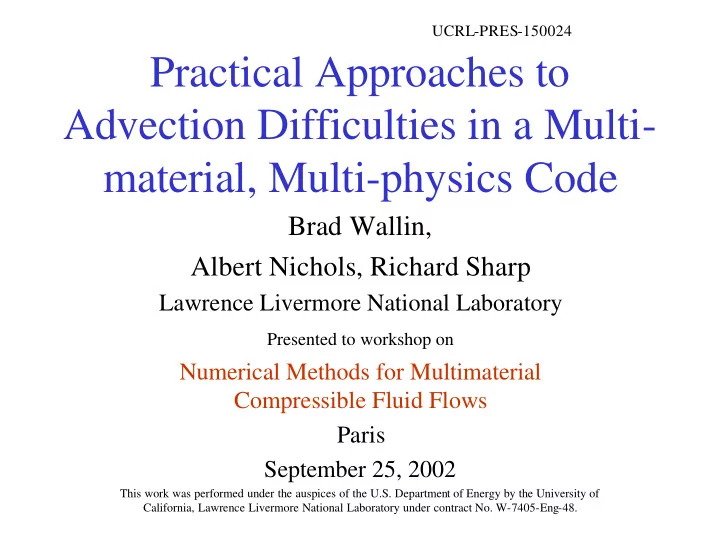

UCRL-PRES-150024 Practical Approaches to Advection Difficulties in a Multi- material, Multi-physics Code Brad Wallin, Albert Nichols, Richard Sharp Lawrence Livermore National Laboratory Presented to workshop on Numerical Methods for Multimaterial Compressible Fluid Flows Paris September 25, 2002 This work was performed under the auspices of the U.S. Department of Energy by the University of California, Lawrence Livermore National Laboratory under contract No. W-7405-Eng-48.
Goals Extend utility of ALE techniques without fundamental changes to underlying algorithms • Code features • Motivation • Slide Surfaces • Reactive Flow • Summary
Code Features • 3D • Unstructured Grid (arbitrarily structured hexahedra) • ALE (Lagrange plus remap) – Equipotential relaxation with nodal weights – 2 nd order Van Leer monotonic advection in pure zones – 1 st order upwind for mixed zones • Multiple material zones • Discontinuous slide surfaces • Thermal diffusion • Chemical reactions • Deflagration models
Motivation • HE Tests – Cylinder tests, Bigplate, Steven test – Used to investigate detonation speed and front shape • Los Alamos annular confinement test – Deflagration in a 3D geometry
Los Alamos annular confinement test Initiation of burn (deflagration) of HE, and tracking burn front between reactants and products PBX-9501 Advection issues: Level set propagates burn between Copper ALE zones Reaction front is treated as a true discontinuity Slide surface between copper and HE requires deletion
Slide Surfaces • Discontinuous mesh slide surfaces • Master/Slave • Slave Relaxation methods – Projection – Parametric – Migration • Master Relaxation • Slide deletion
Parametric Slide Relaxation • “Slave” node returns to same parametric coordinate on nearest “master” face every cycle Lagrange Advection
Slide Deletion • If master and slave nodes perfectly align, slide surface (or part of it) can be deleted if necessary to allow advection normal to the sliding interface • Parametric relaxation ensures the alignment of master and slave nodes • Automatic deletion possible with an activity criterion (i.e. speed) and a grace time
Slide Deletion
Lee-Tarver I&G Reactive Flow • Treat HE as reactant and product with a reaction rate (see below) for the transition • Both Reactant and Product treated with JWL EOS ) ( ) ( η = ⋅ − ⋅ ρ ρ − − r * dF / dt I 1 F / 1 C Ignition 0 ( ) η α + ⋅ − ⋅ ⋅ m G 1 F F p 1 Growth 1 1 ( ) η α + ⋅ − ⋅ ⋅ n 1 G F F p 2 2 Completion 2
Convergence of Reactive Flow (Clark Souers) 8 PBX 9502 JWL++, alternative 5 mm radius ratestick Detonation Velocity (mm /µs) reactive flow model ++ 1, 150 7.5 Different curves ++ 2, 400 ++ 1.38, 247 indicate different 7 pressure exponents I&G, 2, 1500 and rate constants failed 6.5 0 20 40 60 80 Zones/cm “Edge of convergence” is where curves come together and approach right answer
Reactive Flow and ALE • If 80 zones/cm are required, a 3D simulation of the “Steven test” (HE cylinder driven by off-axis impact) would require ~ 100 million zones • Need a way to get more elements in reaction zone without the code infrastructure changes required by AMR
What Can be Done with ALE? • Use nodal relaxation weights to pull mesh elements into the reaction zone • Migrate mesh back behind reaction front, so slave nodes line up with master • Delete parts of slide surface if necessary
Aggressive Relaxation • Assign nodal weights according to the value of the artificial viscosity (in combination with advection sub-cycling) • Migrate slave nodes back according to the value of the relative volume (for program burn) or the burn fraction (for reactive flow) • Delete slide surface nodes based on elapsed time since node became “active”
Aggressive Relaxation: Program Burn Slave nodes migrating back to home Mesh master node Compressed in reaction zone White zones indicate mixing where slide was deleted
Aggressive Relaxation: Artificial Viscosity
Additional Useful Techniques • Relaxation weight propagation • Relaxation weight smoothing – Used in conjunction to smooth regions of disparate relaxation weights • Prevent relaxation in certain key areas – If node has not reached its activity criterion • Suspend relaxation near discontinuities – Rapid variation of chemical species
Aggressive Relaxation can save many zones • Beginning with 1 zone/mm, followed by ratio zoning of the initial mesh, aggressive relaxation can pull 8 zones into the 1mm reaction front
Caveats • Method works best if initial mesh provides enough zones to get started • Significant “tuning” required • Should be possible to mesh confinement and HE separately, as long as the number of slide nodes is equal • Many aspects of method’s behavior not investigated yet • Need to try with different reactive flow models
Conclusions • Aggressive relaxation can save ~5-10X the total number of zones - more in 3D • ALE is a very flexible technique, and simple modifications to the basic algorithms can greatly extend its utility
Acknowledgments • Al Nichols • Mike Murphy • Clark Souers • Craig Tarver • Steve Chidester • Richard Sharp
Recommend
More recommend